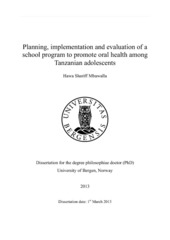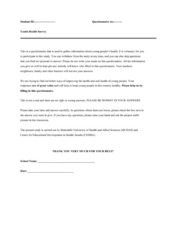| dc.contributor.author | Mbawalla, Hawa S. | en_US |
| dc.date.accessioned | 2013-05-10T09:07:02Z | |
| dc.date.available | 2013-05-10T09:07:02Z | |
| dc.date.issued | 2013-03-01 | eng |
| dc.identifier.isbn | 978-82-308-2233-3 | en_US |
| dc.identifier.uri | https://hdl.handle.net/1956/6598 | |
| dc.description.abstract | Background: The global burden of oral disease and risk behavior is concentrated in underprivileged and poor populations. HPS programs are promising methods for promoting health, including oral health. Objective: The present thesis aimed to collect information about the oral health status, oral health behavior, and oral health-related quality of life among school students and to use this information to implement and evaluate an HPS program that was directed at improving oral health, thereby reducing social inequalities among school adolescents in Arusha, northern Tanzania. Methods: The data in survey I (Papers I–IV) were collected in Arusha, from secondary school adolescents aged 12–21 years at baseline in 2009 and during a follow-up in 2011. Oral health education and demonstrations, wall posters, and the provision of toothbrushes were part of the HPS initiative implemented in April 2010, which was evaluated during March–May 2011. The data in Survey II (part of Paper III) were collected during 2005–2006 in Dar es Salaam from 1601 final year primary school pupils aged 12–14 years. Data were collected using a questionnaire and by clinical oral examinations. Results: In Paper I, 49.8% of boys and 46.8% of girls reported at least one OIDP. The corresponding mean OHI-S scores were 1.2 and 1.0, while the OHI-S and OIDP scores varied in the expected direction with socioeconomic status and health-related behaviors of children. Paper II reports differences in the prevalence scores and the overall mean generic Child-OIDP scores among groups with (DMFT less than 0) and without caries (DMFT = 0), and with and without periodontal problems in Arusha and Dar es Salaam. Paper III, principal component analysis of seven health and oral health-related behaviors gave two factors with Eigen value over 1, accounting for 45.8% of the variance. Confirmatory factor analyses, CFA, provided acceptable fit for the hypothesized two-factor model; CFI = 0.97. Paper IV reports the follow-up study in which 727 students were reexamined clinically. The mean number of teeth with caries increased statistically in both groups from the baseline to the follow-up. The mean number of teeth with gingival bleeding decreased (0.5 versus 0.4; p over 0.05) in intervention schools, whereas it increased in control schools. Conclusion: It may be possible to develop the HPS approach further to include oral health in resource-poor sociocultural settings. Overall, the HPS initiative was effective in reducing the gingival bleeding status of adolescents, but not dental caries, calculus, and plaque. Consequences: The challenge for future studies will be to achieve better and more sustainable results. Despite the limited effects of oral health promotion, its integration within HPS initiatives might be beneficial for Tanzanian secondary school students. | en_US |
| dc.language.iso | eng | eng |
| dc.publisher | The University of Bergen | eng |
| dc.relation.haspart | Paper I: Mbawalla, H. S., Masalu, J. R. & Astrøm, A. N. (2010) Socio-demographic and behavioral correlates of oral hygiene status and oral health related quality of life, the Limpopo-Arusha school health project (LASH): A cross-sectional study. BMC Pediatrics 10:87, November 2010. The article is available at: <a href="http://hdl.handle.net/1956/4636" target="blank">http://hdl.handle.net/1956/4636</a> | en_US |
| dc.relation.haspart | Paper II: Mbawalla, H. S., Mtaya, M., Masalu, J. R., Brudvik, P. & Astrom, A. N. (2011) Discriminative ability of the generic and condition-specific Child Oral Impacts on Daily Performances (Child-OIDP) by the Limpopo-Arusha School Health (LASH) project: a crosssectional study. BMC Pediatrics 11:45, May 2011. The article is available at: <a href="http://hdl.handle.net/1956/5496" target="blank">http://hdl.handle.net/1956/5496</a> | en_US |
| dc.relation.haspart | Paper III: Åstrøm, A. N. & Mbawalla, H. (2011) Factor structure of health and oral health-related behaviors among adolescents in Arusha, northern Tanzania. Acta Odontologica Scandinavica 69(5): 299-309, September 2011. Full text not available in BORA due to publisher restrictions. The article is available at: <a href="http://dx.doi.org/10.3109/00016357.2011.568960" target="blank"> http://dx.doi.org/10.3109/00016357.2011.568960</a> | en_US |
| dc.relation.haspart | Paper IV: Mbawalla, H., Masalu, J. R., Masatu, M. & Åstrøm, A. N. (2013) Changes in adolescents' oral health status following oral health promotion activities in Tanzania. Acta Odontologica Scandinavica 71(2): 333-342, March 2013. Full text not available in BORA due to publisher restrictions. The article is available at: <a href="http://dx.doi.org/10.3109/00016357.2012.680907" target="blank"> http://dx.doi.org/10.3109/00016357.2012.680907</a> | en_US |
| dc.title | Planning, implementation and evaluation of a school program to promote oral health among Tanzanian adolescents | en_US |
| dc.type | Doctoral thesis | |
| dc.rights.holder | Copyright the author. All rights reserved | |

